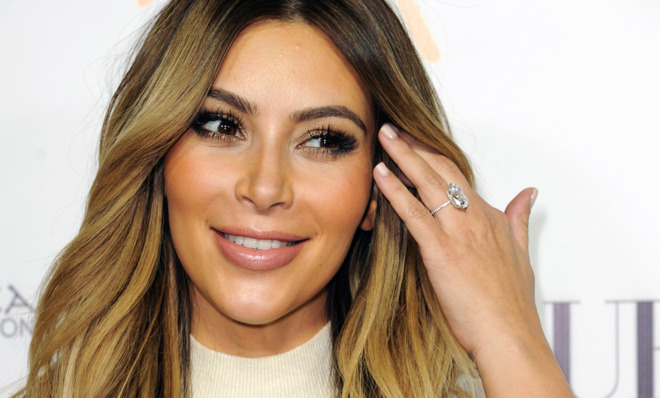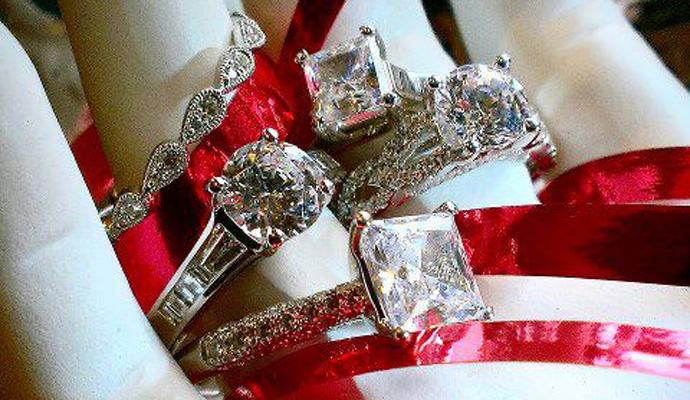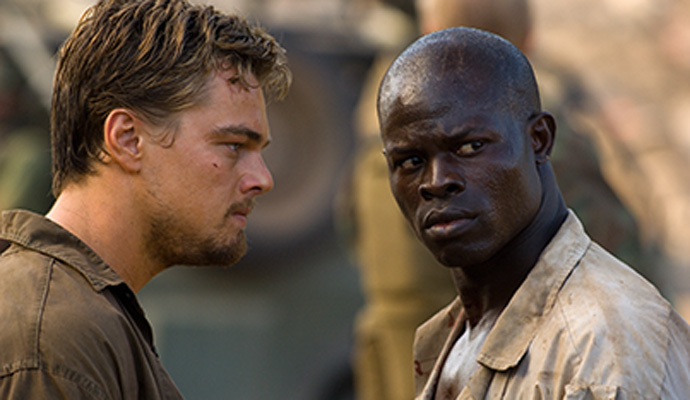How to buy an engagement ring — a man's guide
Before you set out on your ring adventure, young Frodo, you better know a carat from a cut

So, you've decided to propose to your girlfriend — congratulations. And you've decided that instead of her picking out the engagement ring, or designing one together, the most romantic move is to choose it yourself. Congrats again. You are about to embark on an intimidating journey into the wild world of diamond selection.
Chances are, before you decided this, all engagement rings looked pretty much the same: A shiny rock on a pretty band that's going to cost a lot. But if you've already poked around a little, you probably noticed that there are actually between about one squillion and infinity options to choose from — and reams of information about every aspect of the process.
That's why we cobbled together a "diamond engagement ring" how-to guide, with only the information that you need to know.
The Week
Escape your echo chamber. Get the facts behind the news, plus analysis from multiple perspectives.

Sign up for The Week's Free Newsletters
From our morning news briefing to a weekly Good News Newsletter, get the best of The Week delivered directly to your inbox.
From our morning news briefing to a weekly Good News Newsletter, get the best of The Week delivered directly to your inbox.
Preparation
It's not just a cliché: Many girls really do sit around at brunch talking about their fantasy engagement ring. Before you set out on this ring adventure, young Frodo, ask your girlfriend's tightlipped friends for key-words about cut and style.
You'll also want to begin the process knowing your girlfriend's size. If you can borrow a ring from her stash to take to the jewelers, great. If she's a little anal about her jewelry and may notice, use a pencil and a piece of paper to trace the inside of the ring, and bring that instead. Or, slip one on your finger and use a sharpie to mark how far down it slides. And for god's sake, if she's an in-between size, err big. It's easier to size-down, and neither of you want to deal with a mid-proposal knuckle jam.

Cracking the four Cs
A free daily email with the biggest news stories of the day – and the best features from TheWeek.com
Chances are, you know your girlfriend's taste — and her friends may have tipped you off on her favorite cut, or the fact that she despises rose gold. But no one you spoke to has heard her say, "I'd really like a cushion cut, with a split-shank setting and side accents, on a yellow gold band, size seven, nothing lower than an F for color, or SI2 range for clarity, or a two carats — y'know, a classic engagement ring."
That would be way too easy! It is now your job to learn about diamonds — a process that famously starts with the four Cs. Any jeweler will happily provide a full presentation but you'll want to go in prepped. Knowledge is always power over sweet talking salesmen. Here's a quick run-down on ring lingo:
Clarity: This refers to the stone's "inclusions" or imperfections, which include minuscule mineral deposits and fractures in the rock. Many clarity imperfections are too small to see without a magnifying glass, so you may not want to put too much stock in this number. The scale ranges between F, for flawless, to I3, for the most inclusions. SI1 and SI2 have slight inclusions, but will sparkle.

Color: It's not about whether it's a pink or black diamond — but rather the color of a white diamond, from totally colorless to yellow. The clearest diamonds scored D,E, or F. The next tier is G, H, I, and J, and it goes all the way down to Z. Like with clarity, you have breathing room on this.

Cut: This is where personal taste and sparkle come in. The cut grade, which has to do with how well a diamond reflects light, ranges from excellent to poor. Chances are good you've also been briefed on the shapes your girlfriend likes: Round, princess, emerald, pear, marquise, radiant, heart, asscher, cushion, etc. For what it's worth, princess (square) is supposed to be very popular right now. Some shapes reflect light in flashier way than others, as you'll surely notice at the shop.

Carat: That's the weight of the rock, of course. The biggest diamond in the world, the Cullinan diamond, is 3,106.75 carat. The average for an engagement ring is a tad over one carat. The size of the carat you choose will likely have a lot to do with your budget.

After the four Cs, you'll have the ring itself to think about. For setting, the main words to learn are prong, bar, tension, bezel, channel, flush, cluster, invisible, and pave. And for metal it's gold, white gold, rose gold, and platinum. Again, white gold is the most popular, but yellow gold is considered classic. Platinum will jack up the price.
Don't blow the bank
You've likely heard that men should spend between two and three month's salary on an engagement ring. That stat, which is patently ridiculous, probably leads a lot of men to put engagement rings on a credit card. Maybe don't do this? Of course you want your girlfriend to love her ring, but there's a lot of information out there linking divorce to money problems, specifically debt.
Also, know the shortcuts regarding the info above. Take the Carat. Price drops pretty significantly when the carat dips below a whole number. A .9 carat diamond is going to be a lot less expensive than a one carat diamond. Princess, oval, and cushion cuts are all less expensive than round cuts, which cost the most. And the pronged setting is often the least expensive because it uses the least metal.
Also, if you have to go with a tiny carat, there are ways to cheat a little on size. Halo settings, where the rock is surrounded with little baby rocks, can make the rock look bigger and shinier, and oval cuts I'm told look the largest.
And, naturally, consider timing. Do the jewelers you like ever run sales? If so, do they run them leading up to Valentine's Day to push diamond sales? Or after, to clear inventory?
Blood-factor:
If your girlfriend is a Leonardo DiCaprio fan — and she is — she probably saw Blood Diamond, the 2006 film about the diamond trade in the Sierra Leone civil war, and is hip to the fact that a large number of diamonds — something like 25 percent — are mined in war zones and sold to finance war crimes. She may be very uncool with this fact.

Of course, there are ways to leave warlords out of your proposal, but it's trickier than meets the eye. You can ask if the diamond has been through the Kimberly process, though a January article in Foreign Policy says that's essentially a sham. Still, some companies know where their gems are from. If the diamond is from Canada or Australia, it's not financing civil wars. If it's from some countries in Africa, it's a lot less clear.
The jewelry company Brilliant Earth sells conflict-free diamonds and is involved with civil rights issues. If you or your lady want a blood-free diamond, take a look.
Vintage
Of course, the best way around buying a blood diamond: Buying an old diamond. If it was mined 50 or more years ago or more, it did not come from the current conflict. Vintage jewelry also comes with extra sentiment, and depending on her style, extra taste-points for you.
Of course, you'll have more research to do. Know about the difference between Victorian (oldest), Edwardian (second oldest), and Art Deco (third oldest, and most popular) rings. Know that diamond cutting technology has advanced over the years, and old rings may not have the symmetry and shimmer of newer ones. And know that color standards have changed over the years. While bright white is now considered tops, people used to like their diamonds tinted slightly rose, green, or yellow. And finally, know that many really old engagement rings include pearls, which are soft and not great for every day use.
Insurance
After you drop however many paychecks on a ring, get the damn thing insured. You may be carrying it around in your pocket for weeks, waiting for the perfect moment, and if it slips out while you're riding up a chair lift on a ski vacation, you'll want to buy another one.
You can buy it as an extension to your homeowners or rental insurance, or get it from a special jewelry insurer. You'll need a receipt and an appraisal (which costs a fee). You'll want to know how they'll replace the ring. They may offer cash, or they may reimburse you when you buy another ring through a specific jeweler. The Knot lists a few more questions to ask your insurer.
And now, off to start shopping. Best of luck, and god speed!
Carmel Lobello is the business editor at TheWeek.com. Previously, she was an editor at DeathandTaxesMag.com.
-
 Rothermere’s Telegraph takeover: ‘a right-leaning media powerhouse’
Rothermere’s Telegraph takeover: ‘a right-leaning media powerhouse’Talking Point Deal gives Daily Mail and General Trust more than 50% of circulation in the UK newspaper market
-
 The US-Saudi relationship: too big to fail?
The US-Saudi relationship: too big to fail?Talking Point With the Saudis investing $1 trillion into the US, and Trump granting them ‘major non-Nato ally’ status, for now the two countries need each other
-
 Sudoku medium: November 30, 2025
Sudoku medium: November 30, 2025The daily medium sudoku puzzle from The Week